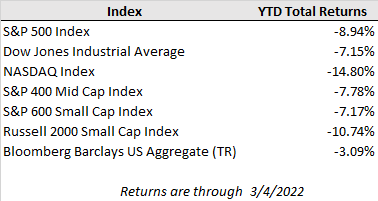The escalating Russia-Ukraine conflict and the growing fallout to commodity markets continued to weigh on equity markets this past week. In the U.S., geopolitical and inflation concerns overshadowed strong manufacturing and labor market reports with the S&P 500 falling 1.2% on the week. However, Europe’s financial markets have felt the brunt of the fallout so far with the MSCI Europe Index tumbling 7.8% last week, or 9.6% in U.S. dollar terms factoring in the impact of a weakening Euro. Meanwhile, rising demand for safe haven assets pushed interest rates lower and lifted precious metal prices higher with gold rallying 4.4%. The 10-year U.S. Treasury closed out the week at 1.72% compared to 1.98% a week ago.
The global coordination, severity, and swiftness of sanctions enforced against Russia have dealt a significant blow to the Russian economy, prompting Moody’s and S&P to cut their sovereign debt ratings deep into junk territory to reflect a high probability of default as their economy is pushed toward collapse. In addition to the sanctions being levied by governments, the private sector has followed suit as many multi-national corporations have cut off sales of their goods and services to Russia. This weekend, major payment processors including Visa, Mastercard, and American Express announced that they will cease all transactions on their networks in Russia.
So far, the Russian energy industry, a major source of cash for their economy, has been spared from direct sanctions as many nations, especially in Europe, are dependent on Russian oil and natural gas. Russia exports 4.3 million barrels of oil per day to Europe and the U.S. that couldn’t be fully replaced in short order. While European leaders are reluctant to move forward with an embargo on Russian energy, a U.S. ban on Russian energy imports has gained bipartisan support among policymakers as Russia supplies roughly only 7% of domestic oil. U.S. crude oil prices have risen to around $120 per barrel, which is about a 60% increase so far in 2022, and consumers are feeling the pressure at the pump as the nationwide average price for gas has pushed past $4 per gallon.
Escalating prices for energy, grain, and metal commodities will likely cut into discretionary spending for consumers, but the U.S. consumer base is bolstered by a strong employment backdrop, healthy personal balance sheets, and rapidly improving Covid case trends to offset some of the pressure. In February, the U.S. job market once again outpaced expectations adding 678k new payrolls to the economy compared to expectations for just 400k net new jobs. The unemployment rate fell to just 3.8%.
In the week ahead, the Federal Reserve will get its final reading of inflation before embarking on rate hikes at its meeting later this month. February’s CPI report is expected to show a 7.8% year-over-year increase in consumer prices. The Fed is expected to begin hiking rates later this month, albeit at a slower pace, as economic challenges and uncertainty posed by the Russia-Ukraine conflict have tempered rate hike expectations. The market is now pricing in expectations for almost six 0.25% rate hikes in 2022, though this is down from expectations for up to seven hikes last month. The path of rate hikes may decline further if geopolitical tensions continue to take a bite out of global economic growth.
Amid this backdrop of near-term uncertainty and elevated market volatility, our team at First Merchants Private Wealth Advisors is here to assist you in reviewing your risk and return objectives and ensuring that your asset allocation is optimal relative to your financial goals. Please feel free to reach out to your First Merchants advisor if you have questions or concerns.



